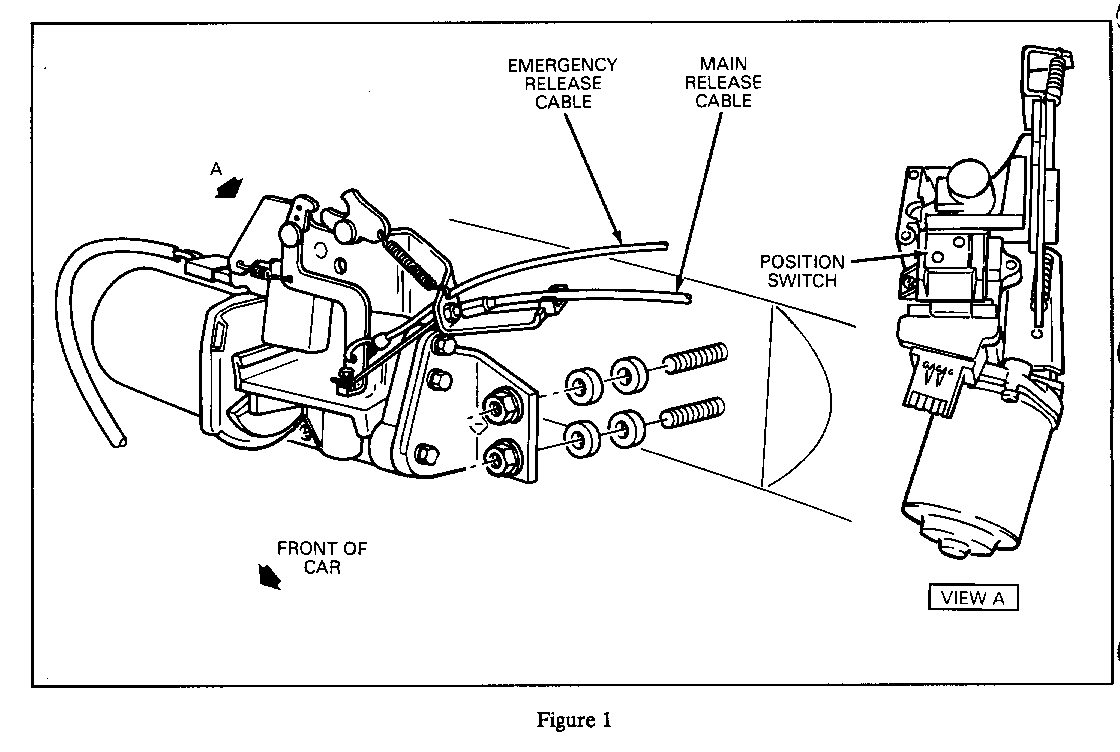TOP PULLDOWN MOTOR CYCLES CONT (DIAG./REPLACE PULLDOWN MOTOR)

SUBJECT: TOP PULLDOWN MOTOR CYCLES CONTINUOUSLY (DIAGNOSE/REPLACE PULLDOWN UNIT)
VEHICLES AFFECTED: 1987-92 CADILLAC ALLANTE
Some 1987-1992 Allantes may experience a condition where the top pulldown unit cycles up and down continuously after unlatching or latching the rear bow. This condition is caused by an unwanted ground being supplied to the pulldown unit or a misadjusted soft top hook position switch.
I. PULLDOWN UNIT CYCLES AFTER UNLATCHING THE SOFT TOP -------------------------------------------------- If the condition occurs after unlatching the rear of the top, an unwanted ground is being supplied to the motor. Typically, the unwanted ground is caused by a chafed or pinched wiring harness at the pulldown unit or a chafed or pinched main release cable near the left rear speaker housing. To repair this condition use the following service procedure:
1. Remove the pulldown unit from the stowage well, and inspect the wiring harness conduit in the immediate vicinity for cuts, chafing, or pinch marks. Be sure to check the portion of the harness which runs up to the pulldown unit jaws. If suspect, open the conduit and inspect for wire damage. Repair wiring as needed.
2. If the wiring harness appears okay, disconnect all wiring connections at the pulldown unit (one motor connection and the wire screwed to the jaws). Check for a short to ground on circuit #739 on 1990-1992 models or *897 on 1987-1989 models. Refer to Section 8A, Cell 121-0 for circuit details. Repair short as necessary.
3. If the wiring checks okay, inspect the main release cable housing for chafing or cuts that allow the metal cable inside to contact a grounded surface. Especially check the cable assembly where it passes behind the left rear speaker housing and near the shoulder belt retractor on its way to the release handle behind the driver's seat. If grounded, repair or replace the cable as necessary.
4. If the main release cable appears okay, replace the pulldown unit for an internal short.
For vehicles repaired under warranty. use: 6 hour plus diagnosis time of 0-.3 hour depending on actual time used.
II. PULLDOWN UNIT CYCLES AFTER LATCHING THE SOFT TOP ------------------------------------------------ If the pulldown unit cycles continuously after the soft top is latched in the rear, the soft top hook position switch is out of adjustment. Refer to Figure 1. To repair this condition use the following service procedure:
1. Unlatch the rear of the soft top and open the stowage cover. Verify that the metal extension arm on the position switch is free to move and not physically distorted or damaged. If distorted or damaged, repair or replace pulldown unit as necessary.
NOTE: A distorted or damaged extension arm indicates excessive force has been used in latching the rear bow. To prevent a recurrence, ensure that the soft top is operating properly and make sure the customer understands the procedure for raising the top before returning the vehicle.
2. If the metal extension arm is OK, cycle the pulldown unit downward using the pulldown unit rocker switch behind the driver's seat. As the unit is moving downward, manually depress the position switch and check if the unit shuts off when it reaches the bottom of its travel. If the unit does shut off, reform the metal extension arm on the switch slightly upward and try latching the soft top down. Repeat the reforming operation as necessary until the soft top hook will shut the pulldown unit off at the bottom of its travel.
3. If the position switch does not shut the pulldown unit off when manually depressed, replace the pulldown unit for an internally shorted switch.
For vehicles repaired under warranty use: .2 hour for hook position switch adjustment and .6 hour if pulldown unit is replaced.

General Motors bulletins are intended for use by professional technicians, not a "do-it-yourselfer". They are written to inform those technicians of conditions that may occur on some vehicles, or to provide information that could assist in the proper service of a vehicle. Properly trained technicians have the equipment, tools, safety instructions and know-how to do a job properly and safely. If a condition is described, do not assume that the bulletin applies to your vehicle, or that your vehicle will have that condition. See a General Motors dealer servicing your brand of General Motors vehicle for information on whether your vehicle may benefit from the information.
